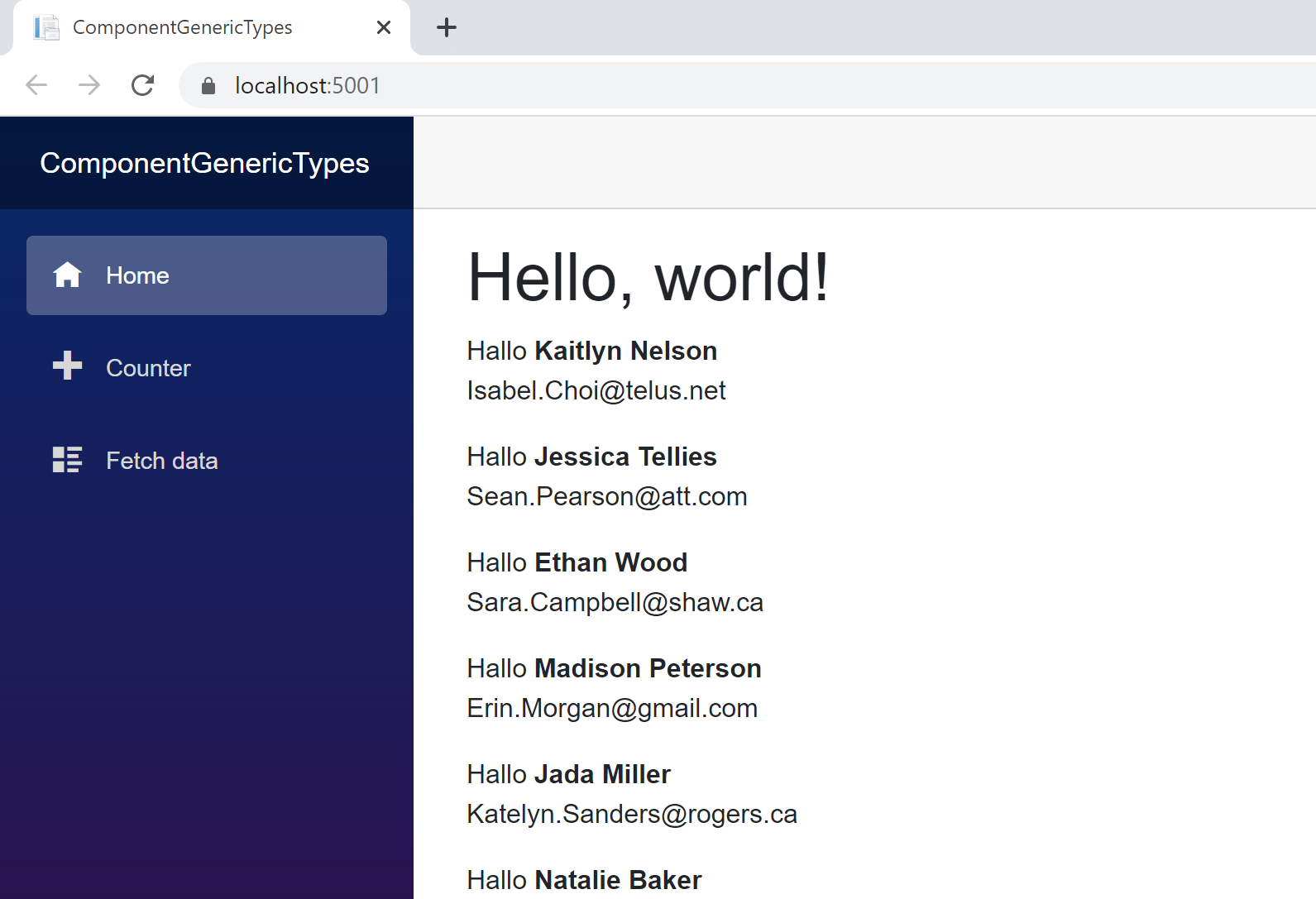ASP.NET Core in .NET 6 - Infer component generic types from ancestor components
Jürgen Gutsch - 01 June, 2021
This is the ninth part of the ASP.NET Core on .NET 6 series. In this post, I'd like to have a look into the inferring of generic types from ancestor components.
In Blazor generic ancestor components need to have the generic type defined in the markup code, until yet. With the preview 2 of .NET 6 ancestor components can infer the generic type from the parent component.
In the announcement post, Microsoft shows a quick demo with the Grid component. Let's have a quick look at the snippets:
<Grid Items="@people">
<Column TItem="Person" Name="Full name">@context.FirstName @context.LastName</Column>
<Column TItem="Person" Name="E-mail address">@context.Email</Column>
</Grid>
In this snippet, the Column component has the generic type with the TItem property. This is not longer needed as they showed with this sample:
<Grid Items="@people">
<Column Name="Full name">@context.FirstName @context.LastName</Column>
<Column Name="E-mail address">@context.Email</Column>
</Grid>
Since I don't like grids at all, I would like to try to build a SimpleList component that uses a generic ListItem ancestor component to render the items in the list:
Try to infer generic types
As usual, I have to create a project first. This time I'm going to use a Blazor Server project
dotnet new blazorserver -n ComponentGenericTypes -o ComponentGenericTypes
cd ComponentGenericTypes
code .
This creates a new Blazor Server project called ComponentGenericTypes, changes into the project directory, and opens VSCode to start working on the project.
To generate some meaningful dummy data, I'm going to add my favorite NuGet package GenFu:
dotnet add package GenFu
In the Index.razor, I replaced the existing code with the following:
@page "/"
@using ComponentGenericTypes.Components
@using ComponentGenericTypes.Data
@using GenFu
<h1>Hello, world!</h1>
<SimpleList Items="@people">
<ListItem>
<p>
Hallo <b>@context.FirstName @context.LastName</b><br />
@context.Email
</p>
</ListItem>
</SimpleList>
@code {
public IEnumerable<Person> people = A.ListOf<Person>(15);
}
This will not work yet, but let's quickly go through it to get the idea. Since this code uses two components that are located in the Components folder, we need to add a using of ComponentGenericTypes.Components, as well as a using to ComponentGenericType.Date because we like to use the Person class. Both the components and the class don't exist yet.
At the bottom of the file, we create a list of 15 persons using GenFu and assign it to a variable that is bound to the SimpleList component. The ListItem component is the direct child component of the SimpleList and behaves like a template for the items. It also contains markup code to display the values.
For the Person class I created a new C# file in the Data folder and added the following code:
namespace ComponentGenericTypes.Data
{
public class Person
{
public string FirstName { get; set; }
public string LastName { get; set; }
public string Email { get; set; }
}
}
This is a pretty simple class. But the property names are important. If such a class is instantiated by GenFu, it automatically writes first names into the FirstName property, last names into the LastName property and it also writes valid email addresses into the Email property. It also works with Streets, Addresses, ZIP codes, phone numbers, and so on. This is why GenFu is my favorite NuGet package.
Now let's create a Components folder and place the SimpleList component inside. The code looks like this:
@typeparam TItem
@attribute [CascadingTypeParameter(nameof(TItem))]
<CascadingValue IsFixed="true" Value="Items">@ChildContent</CascadingValue>
@code {
[Parameter] public IEnumerable<TItem> Items { get; set; }
[Parameter] public RenderFragment ChildContent { get; set; }
}
It defines the generic type parameter TItem and a property called Items that is of type IEnemuerable of TItem. That makes the component generic to use almost any kind of IEnumerables. To use child components, the SimpleList also contains a RenderFragment property called ChildContent.
The second attribute does the magic. This cascades the generic type parameter of a specific type to the child component. This is why we don't need to specify the generic type in the ancestor component. In the third line, we also cascade the property Items to the child component.
Now it's time to create the ListItem component:
@typeparam TItem
@foreach (var item in Items)
{
<div>@ChildContent(item)</div>
}
@code {
[CascadingParameter] public IEnumerable<TItem> Items { get; set; }
[Parameter] public RenderFragment<TItem> ChildContent { get; set; }
}
This component iterates through the list of items and renders the ChildContent which in this case is a generic RenderFragment. The generic one creates a context variable of type TItem that can be used to bind the passed value to child components or HTML markup. As seen in the Index.razor the context variable will be of type Person:
<ListItem>
<p>
Hallo <b>@context.FirstName @context.LastName</b><br />
@context.Email
</p>
</ListItem>
That's it! The index page now will show a list of 15 persons:

Since I'm not really a Blazor expert the way how I implemented the components might be not completely right, but it's working and shows the idea of the topic of this blog post.
What's next?
In the next part In going to look into the support for Preserve prerendered state in Blazor apps in ASP.NET Core.
